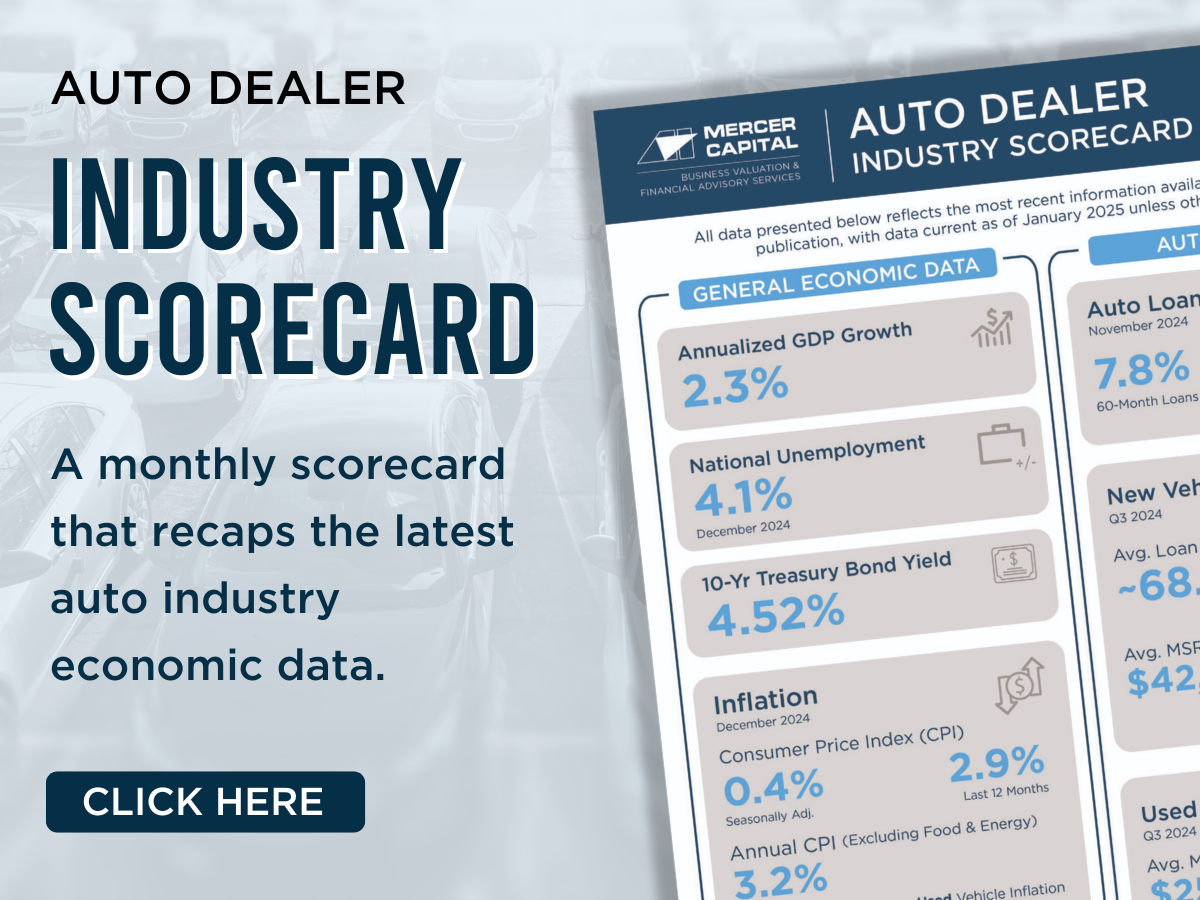Understanding the value of an auto dealership is crucial during significant life events, strategic planning, or potential sale. This piece offers a comprehensive look at various scenarios that might necessitate a business valuation, such as estate planning, death of a dealer principal, and buy/sell agreements. Get to know how regular valuations can help track your dealership’s value over time, enhancing strategic decisions, and preparing for potential offers or disputes.
Category
Valuation Issues
What Is the Value of My Auto Dealership?
It Depends on Who's Buying
Wondering what your auto dealership is worth? This post gives practical illustrations of how buyers might determine the premiums or discounts they are willing to pay for your dealership. Discover the unique facets that shape the value of your auto dealership through the lens of three distinct buyer types: strategic, financial, and minority interest. Understand the dynamics influencing your dealership’s value and arm yourself with knowledge for future negotiations.
Middle Men: Family-Owned Auto Dealerships
As an auto dealer, you may be wondering what is my dealership worth? In this video, Scott Womack discusses the key value drivers of an auto dealership.
Plan for the Unexpected
Succession Planning for Auto Dealers
The 2023 NCAA College Basketball Tournament began last week. Many of us have been checking our brackets obsessively. There’s a reason it’s called March Madness. Who would have predicted that Fairleigh Dickinson would upset Purdue or that Princeton would upset Arizona and advance to the Sweet 16? The tournament and its bracket challenges are full of possibilities but are also a source of frustration, given the unexpected twists and turns. In certain ways, succession planning for auto dealers mirrors the journey through the tournament. Just as the thought of a #16 seed beating a #1 seed wasn’t on our radars before 2018 (when #16 University of Maryland-Baltimore County beat #1 Virginia 74-54 on March 16, 2018), thoughts of a global pandemic or an inventory crisis caused by a microchip shortage weren’t expected either. The lesson to be learned: Plan for the unexpected.
In this post, we discuss some of the key factors to be considered in the succession planning process and why they are critical.
2022 Auto Dealer Industry Metrics Review
Has Profitability Peaked?
As we turn the calendar to March, 2022 is in the rearview mirror, and year-end statistics for the auto industry have been released. How did the industry perform, and what do the metrics tell us about the direction of the industry in 2023? In this post, we discuss the key metrics we track for the industry: new vehicle profitability, the supply of new vehicles, average trade-in equity values of used vehicles, the used-to-new vehicle retail unit sales ratio, fleet sales, and vehicle miles traveled.
LOV(E): Why Getting the Level of Value Right Is So Important to Auto Dealers
Part II
In this two-part series, we continue our exploration of the “Levels of Value.” The Levels of Value refer to the idea that while “price” and “value” may be synonymous, they don’t quite mean the same thing. A nonmarketable minority interest level of value is very different from a strategic control interest level of value. Last week we described each Level of Value and why the concept is so important to auto dealers.
This week, we discuss four potential transactions in which selecting the appropriate level of value is critical and explain why: 1) estate planning, 2) corporate development, 3) divestitures, and 4) shareholder redemptions.
LOV(E): What Are the “Levels of Value” and Why Does It Matter to Auto Dealers?
Part I
In the spirit of Valentine’s Day, we cover a topic that may seem too theoretical; however, the shareholders in your business must understand it – LOV – or the “Levels of Value.” The Levels of Value refers to the idea that while “price” and “value” may be synonymous, they don’t quite mean the same thing. A nonmarketable minority interest level of value is very different from a strategic control interest level of value. In this week’s post, we explain what each level means and how each specifically relates to auto dealers. This will be the first part of a two-part blog series.
Six Things to Consider When Working with a Business Appraiser
We’ve turned the page on 2022, another year defined by challenges, record profitability and elevated valuations for auto dealers. As we enter 2023, there will likely be unique challenges and opportunities for auto dealers regarding business valuations. We will dedicate future posts to the discussion of these opportunities from the perspective of succession planning in an environment with sunsetting tax exemptions and depressed asset values, especially if interest rates continue to rise and profitability subsides in 2023.
We previously discussed six events that could trigger the need for a business valuation. In this week’s post, we discuss six things that attorneys and auto dealers should consider when selecting or working with a business appraiser.
Market Insights on Auto Dealer M&A Activity
A few weeks ago, I sat down with Kevin Nill of Haig Partners to discuss the current state of the M&A market and other timely trends in the auto dealer industry. Specifically, we discussed some of the movements in Blue Sky multiples for various franchises and interpret the range of multiples that Haig Partners recently published with the release of their Second Quarter 2022 Haig Report.
Mid-Year 2022 Auto Dealer Industry Newsletter Release
We are pleased to release our latest edition of Value Focus: Auto Dealer Industry Newsletter. The newsletter features a commentary on industry data from mid-year 2022. Additionally, this issue includes two timely articles: “2022: How Is the Auto Industry Doing and What Does the Future Hold?” and “Earnings Calls: Executive Summary.”
Powersports: Alternative Growth Opportunity for Auto Dealers
Auto dealers have experienced heightened profitability over the last two years. For dealers with excess cash from continued profits or remaining PPP funds, have you thought about the powersports industry? As one auto dealer client recently recounted to us, “if you have the skills and experience in selling high volumes of automobiles to consumers, then you have the necessary skills to also succeed in the powersports industry.” In this post, we explain what the powersports industry is and how big it is, as well as highlight similarities and differences to the traditional auto dealer industry for those interested in possibly entering this industry.
Q2 2022 Earnings Calls
Persistent New Vehicle Inventory Shortages Keep Days’ Supply Low and Pre-sales High - Consumers May Be on Shakier Ground, But Demand is Still Strong
Supply issues continue to dominate the industry with no end in sight. This week we discuss supply issues along with three other themes that were discussed during the Q2 earnings calls.
2022: How Is the Auto Industry Doing and What Does the Future Hold?
Status Quo or Winds of Change?
The first half of 2022 is behind us, and with school about to start, report cards will be here before we know it. In that same light, the auto industry has published its statistics for the first six months. This post reviews predictions by industry analysts (and us) made at the beginning of the year by analyzing several key metrics. Additionally, we discuss threats that arose during the first half of 2022 and their impact on the auto industry for the remainder of the year and perhaps longer. Finally, we offer a few predictions for the second half of 2022.
State of the Industry From the Tennessee Automotive Association Convention
Musings From Mercer Capital’s Music City Office
Last week we attended the Annual Tri-State Convention for the Automotive Associations of Tennessee, Mississippi, and Alabama. The event provided a great opportunity to discuss trends in the automotive industry with industry participants and dealers from different manufacturers and geographic areas. In this blog, we discuss some of the trends discussed last week, including a variety of topics that we have covered before in this space. We also incorporate highlights of a presentation from noted industry analyst Glenn Mercer (no affiliation with Mercer Capital) regarding the “Dealership of Tomorrow.”
An Overview of Auto Finance
Credit Risk, Trends, Used vs. New Vehicle Sales
Auto dealers across the country rely on their Finance and Insurance (F&I) departments for a significant portion of their revenue. While top-line revenue in these departments typically makes up a small portion of a new car dealership’s total revenue mix, they have much better margins than their selling division counterparts. Third-party lenders play a larger role in the financing process for used dealers who do not have their own captive finance operations, and the economics are typically different from their new vehicle-selling counterparts.
We look at the layout and current state of the auto finance industry, as well as quotes from public auto executives about the current financing environment in this blog post.
Smart Connected Cars, OTAs, and Their Impact on Auto Dealers
The Future of Automobiles
Connected cars are an undiscussed subplot in the current inventory crunch as more tech-enabled vehicles require more microchips, which as everyone knows by now are in short supply. In this post, we examine the size and growth of the connected car segment and discuss the struggle between auto manufacturers/OEMs and auto dealers over servicing these features.
Case Review: Observations From a Recent Auto Dealer Litigation
The valuation of auto dealerships can be very challenging and complex. This week we discuss a recent Appellate Court decision, released from a case (Thomas A. Buckley v. Grover C. Carlock, Jr. et.al.) that we were directly involved in back in 2019. The case centered around a shareholder oppression issue involving a minority owner of an “ultra-high-line” auto dealership. Mercer Capital was hired by the Defendant to serve as the expert witness.
Succession Planning for Auto Dealers
Sorting Through the Madness
What is succession planning? Succession planning is the transfer of value or leadership in a company or organization. For auto dealers, the dealership can represent a lifetime of efforts and relationships with key employees and customers.
This post discusses some of the key factors involved in the succession planning process and why they are so critical.
Price vs. Value
How Can the Conclusion of Value for the Same Auto Dealership Be Different?
“Price” and “value” are terms that are often used interchangeably but their meaning may not be synonymous in the context of a private business, or in this case an auto dealership. In this post, we examine the differences between “price” and “value.”
LOV(E): Why Getting the Level of Value Right Is So Important to Auto Dealers
Part II
In this two-part series, we continue our exploration of the “Levels of value.” The Levels of Value refer to the idea that while “price” and “value” may be synonymous, they don’t quite mean the same thing. A nonmarketable minority interest level of value is very different from a strategic control interest level of value. Last week we described each Level of Value and why the concept is so important to auto dealers.
This week, we discuss four potential transactions in which selecting the appropriate level of value is critical and explain why: 1) estate planning, 2) corporate development, 3) divestitures, and 4) shareholder redemptions.
LOV(E): What Are the “Levels of Value” and Why Does It Matter to Auto Dealers?
Part I
In the spirit of Valentine’s Day, we cover a topic that may seem too theoretical; however, the shareholders in your business must understand it – LOV – or the “Levels of Value.” The Levels of Value refers to the idea that while “price” and “value” may be synonymous, they don’t quite mean the same thing. A nonmarketable minority interest level of value is very different from a strategic control interest level of value. In this week’s post, we explain what each level means and how each specifically relates to auto dealers. This will be the first part of a two-part blog series.
Don’t Turn a Blind Eye to Fixed Operations
A Look at the Importance and Stability of Fixed Operations
While fixed operations may not be grabbing any of the current headlines, auto dealers should remain focused on their importance and stability to the overall success and profitability of a dealership. In this blog post, we analyze the recent historical contribution of fixed operations to overall dealership metrics, analyze several key indicators of future performance, and explore several myths and the changing landscape of the service department and customer relationship.
The Future of Auto Dealerships
How Inventory Shortages and Electric Vehicles May Shape the Future of Automotive Retail
Just as December is a good time to look back and reflect, January is a good time to look forward, to 2022 and beyond. When we value auto dealerships, we look back at performance in prior years because this helps to inform reasonable expectations for future performance. Prior to the pandemic, the directly preceding twelve months of performance may have been a reasonable proxy for ongoing expectations. However, throughout 2020 and 2021, discussions about when things will return to “normal” or whether we’re in the “new normal” have taken center stage.
In order to look forward, we must also consider the past, or as Shakespeare’s Antonio would say, “What is past is prologue.” In this post, we look at two key trends in 2021 (inventory shortages and electric vehicles/direct selling) and how they may inform how automotive retailing will look in the future.
Q3 2021 Earnings Calls
Q3 earnings calls across the group of public auto dealers began with similar themes from the prior two quarters: record profits and earnings, record Gross Profits Per Unit (GPU) on new and used vehicles, and tightening inventory conditions. In addition to those themes, we also discuss M&A, inflation, and other areas of profitability for the public auto dealers.










